New Years Day – Thursday 1st January – Leominster – It is damp and frosty. Robins sing around the Grange. Rooks and Carrion Crows are calling from all directions. 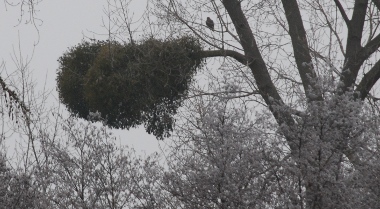 Eaton Hill, across the river, is shrouded in mist. It is strange that it is a new year as it seems pretty much like yesterday. Indeed, before 1752, in England the new year started on 25th March, the start of spring. It still seems more obvious to start the year at a point of change, such as after the winter solstice on 21st December or as in the past on the spring equinox. It was the Romans who fixed the date as 1st January in 153BCE for military reasons. Maddy crashes through the undergrowth along the eastern side of the graveyard, but it is now light and the rabbits she seeks have retreated to their burrows. Later in the morning Maddy and I head off down to the meadows across the river. Long-tailed Tits cavort and tumble in the tree outside the newsagents. A flock of Fieldfares wing eastwards. The bridge over the railway is encrusted with ice. Into the meadows where the silhouette of a woodpecker flashes past – Great Spotted, I think. The trees are black skeletons with tumescences of mistletoe. Smaller Alder saplings are pale with frost. A Common Buzzard alights in a tree by the by-pass. It then moves over into one of the tall trees by the river bank. A flock of Lapwings flies slowly down the valley.
Eaton Hill, across the river, is shrouded in mist. It is strange that it is a new year as it seems pretty much like yesterday. Indeed, before 1752, in England the new year started on 25th March, the start of spring. It still seems more obvious to start the year at a point of change, such as after the winter solstice on 21st December or as in the past on the spring equinox. It was the Romans who fixed the date as 1st January in 153BCE for military reasons. Maddy crashes through the undergrowth along the eastern side of the graveyard, but it is now light and the rabbits she seeks have retreated to their burrows. Later in the morning Maddy and I head off down to the meadows across the river. Long-tailed Tits cavort and tumble in the tree outside the newsagents. A flock of Fieldfares wing eastwards. The bridge over the railway is encrusted with ice. Into the meadows where the silhouette of a woodpecker flashes past – Great Spotted, I think. The trees are black skeletons with tumescences of mistletoe. Smaller Alder saplings are pale with frost. A Common Buzzard alights in a tree by the by-pass. It then moves over into one of the tall trees by the river bank. A flock of Lapwings flies slowly down the valley.
Friday 2nd January – Leominster – It seems slightly less cold as we head across the Grange. It is still murky in the dawn gloom. The rabbits have already retreated to their burrows so Maddy has little to chase. We round the corner and pass the old Priory Infirmary when it begins to snow. It has stopped by the time we reach home. Later on it is off down to the river meadows to try and burn off some of Maddy’s boundless energy. Round into the Woodland Trust plantation. The saplings are close together but a Common Buzzard still manages to silently glide between them, just a couple of feet off the ground. Great Tits are calling but their song has not yet attained the constant rhythmic flow that will emerge in spring. Another much larger Common Buzzard is sitting in a tree on Eaton Hill. It sees me and glides away eastwards. A Green Woodpecker flashes between the trees and disappears. By the time we return to the river, there is a constant dripping sound as the thaw sets in and by midday the sun is out.
Tuesday 6th January – Dinmore Hill – The past few nights have been bitterly cold with temperatures falling several degrees below freezing. The Queenswood Park has a dusting of snow. From the lookout point the view across Herefordshire is obscured by a haze and blinding sun. A chain saw snarls in the woods below. Off down the trail where a small flock of Redwings rise from the woodland floor. Three Jays fly through the tree tops, barking gutturally. The path passes through a grove of Redwoods. The lofty trees have dark chestnut trunks that are glowing in the thin sun.
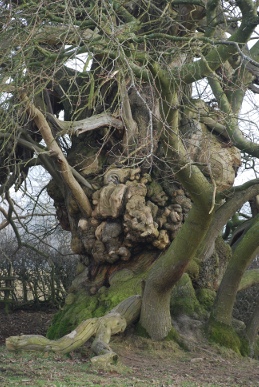
Friday 9th January – Croft Ambrey – Off to Croft past apple orchards with Fieldfares standing in the trees. From Croft Castle a track leads northwards, gently climbing. It is a cold day but the sun is shining with a winter weakness. The track passes an estate cottage and a field of sheep and cattle. The latter, beefy black beasts, have little red and white calves. In the other direction are tall trees, bare limbs reaching darkly into the sky. The black silhouette of a Common Buzzard hunches on a branch. The path passes a quarry that would have provided much of the building stone for the castle. The next field contains the end of the famous avenue of Spanish Chestnuts – ancient, blasted hulks often with only a single branch indicating any sign of living wood. The track continues into Croft Wood, Forestry Commission woodland. Great conifers have fallen and small saplings rise directly out of the rotting trunks. Broadleaf pollards have stood here for centuries providing wood for fires and charcoal. The Commission plans to steadily removed all the conifers and return to the original, broadleaf woodlands.
The path drops down briefly before climbing across a common of bracken and Hawthorns. Ahead on the skyline are the high southern 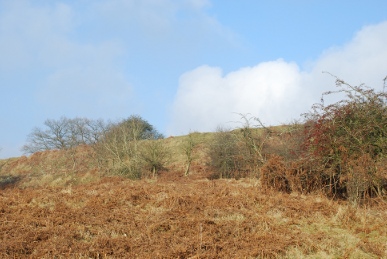 ramparts of the fort. The path passes around the western edge where Yatton Hill drops away and then up onto the camp. The camp is triangular and covers some 32 acres. The hilltop was first settled around 1050BCE and saw at least 15 different periods of construction. The fortifications were hugely reconstructed around 390BCE and comprised the present innermost rampart with its two outer banks separated by two ditches. The original eastern entrance was remodelled and the western entrance may have continued as a postern and a new south-western gate was added and here 15 periods of construction have been uncovered. Both incorporated guard chambers and metalled roadways. Huts have been excavated that indicate the site was burnt out in the 1st century CE, almost certainly by the Romans. Pottery has been found of a distinctive Malvern design. The path continues across the camp until it reaches the severe scarp slope to the north where the land drops away down Leinthall Common. The hillside opposite is being destroyed by a massive quarry – the repeating klaxons of reversing vehicles can be heard. The village of Leinthall Earls lays far below.
ramparts of the fort. The path passes around the western edge where Yatton Hill drops away and then up onto the camp. The camp is triangular and covers some 32 acres. The hilltop was first settled around 1050BCE and saw at least 15 different periods of construction. The fortifications were hugely reconstructed around 390BCE and comprised the present innermost rampart with its two outer banks separated by two ditches. The original eastern entrance was remodelled and the western entrance may have continued as a postern and a new south-western gate was added and here 15 periods of construction have been uncovered. Both incorporated guard chambers and metalled roadways. Huts have been excavated that indicate the site was burnt out in the 1st century CE, almost certainly by the Romans. Pottery has been found of a distinctive Malvern design. The path continues across the camp until it reaches the severe scarp slope to the north where the land drops away down Leinthall Common. The hillside opposite is being destroyed by a massive quarry – the repeating klaxons of reversing vehicles can be heard. The village of Leinthall Earls lays far below.
Thursday 15th January – Eaton Hill – It takes an age to get down the street as I am making a determined effort to stop Maddy pulling – with only limited success. She then acts perfectly crossing the railway, sitting and waiting for me to catch up before moving on. She then manages to lose her ball on only the third throw. She is useless at searching for it, spends most her time looking indignantly at me. The ball is lost so we move on. The fields below Eaton Hill are greening with the 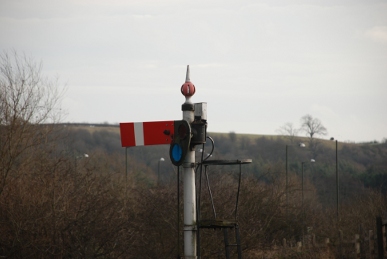 shoots and leaves of new crops. From the hill the west looks dark and threatens rain. It is slippery along the paths. At the top of the slope where the drovers’ trail climbs, a Great Tit is in full song, repeating like a rusty bicycle wheel. The old A44 crosses the A49 and then climbs a slope to a large bridge over the railway. Just before the tracks is a drainage ditch which goes under an old bridge which sticks out of the embankment some way below. Beside the bridge is a fine old GWR style semaphore railway signal – the type that drops down rather than rises to indicate all clear. It seems to have its original oil lamp housing, although an electric cable now runs into its back. Back home, I have purchased a larger chicken feeder for when we go away. As I put it in place I can hear the cronk of a Raven and shortly one flies overhead.
shoots and leaves of new crops. From the hill the west looks dark and threatens rain. It is slippery along the paths. At the top of the slope where the drovers’ trail climbs, a Great Tit is in full song, repeating like a rusty bicycle wheel. The old A44 crosses the A49 and then climbs a slope to a large bridge over the railway. Just before the tracks is a drainage ditch which goes under an old bridge which sticks out of the embankment some way below. Beside the bridge is a fine old GWR style semaphore railway signal – the type that drops down rather than rises to indicate all clear. It seems to have its original oil lamp housing, although an electric cable now runs into its back. Back home, I have purchased a larger chicken feeder for when we go away. As I put it in place I can hear the cronk of a Raven and shortly one flies overhead.
Saturday 17th January – Brighton – It is a wild and windy morning. The sea is hidden in mist and cloud. Hollingbury Woods have clear, well marked tracks, different from the narrow muddy paths of my youth. The trees have filled out to become a dense woodland again after the
devastation of the storm of 1987 which blew down a majority of them. Out on the golf course Herring Gulls yelp noisily. Later in the morning I head down to London Road. This was always the cheaper shopping area compared to the Western Road but now it really run down. The great Co-op store is an empty hulk. Many shops are boarded up. Sainsbury’s has moved to a brand new store up near
“Let nothing check the descent of those glorious beams of sunlight which fall at Brighton. Watch the pebbles on the beach: the foam runs up and wets them, almost before it can slip back the sunshine has dried them. So they are alternately wetted and dried. Bitter sea and glowing light, bright, clear air, dry as dry – that describes the place.”
Richard Jefferies (1848-1887)
the station – an Aldi is going to replace it. Back up the hill and over the railway by London Road station. On the other side I am bemused that someone thinks “Open House” is a better name for a pub than “The Springfield”. Herring Gulls are positioned on the chimney stacks making an appalling racket.
Sunday 18th January – Heart of England – We leave Brighton and have a quick stop in Hove on the seafront. It is probably the first time Maddy has seen the sea and she is, as with everything, frantic with excitement. She attempts to sniff the froth left as the wave retreats and is then astonished when another wave heads towards her. It takes nimble footwork to avoid a soaking. Our route is a bit erratic – I did not mean to end up on the M27 for miles! But we eventually head north-west. For many miles we travel on the great Roman road, Ermine Street. It is a strange sensation to think that just under two thousand years ago, a hundred generations, soldiers were marching along the route we are now traversing at a much greater speed.

Friday 23rd January – Mortimer Forest – After a night of rain there are blue skies this morning. I follow the forestry track that leads around the south of the forest from Black Pool. There is much green around, the darker greens of the conifers and bramble leaves and brighter shades from grasses and sedges. The sun is bright. A conifer displays leaves of green and silver. A streamlet scurries down beside the path providing Maddy with plenty of splashing and drinking water. Apart from the occasional call from a Great Tit the only sound is the constant background rustling of the trees in the wind. The track swings round and up to Haye Park House – a fine farm house with outbuildings which was a working farm until the 1980s when the Forestry Commission sold it. The house was built in the mid-17th century by Colonel Richard Salwey, at one time Secretary to Cromwell and MP for Appleby. Another Richard Salwey built Moor Park House which lays down in the valley on the opposite side of the Ludlow-Richards Castle road in the 1720s. The house became Lancing College during the Second World War when the college at Lancing in West Sussex was evacuated. After the war, the house continued as a private school. A  track leads back down the hill some way until it meets one of the main forestry roads which is at present a muddy track. This road leads up to and past the Iron Age enclosure. Foxglove leaves are developing along the roadside. From here there are views across the valley towards Clee Hill and down south-eastwards where the Malvern Hills lay on the horizon.
track leads back down the hill some way until it meets one of the main forestry roads which is at present a muddy track. This road leads up to and past the Iron Age enclosure. Foxglove leaves are developing along the roadside. From here there are views across the valley towards Clee Hill and down south-eastwards where the Malvern Hills lay on the horizon.
The track continues around the hillside below Sunny Dingle. An exposed patch beside the road shows the layers of Silurian limestone that makes up much of the area. A path leads down the hill but I can see that it turns into deep mud some way down. There is another path on the map further around the bend. This path leads into the conifer woods. There are vehicle tracks down this path but the branches hang very low and I am ducking under them for some time, with the result of a very wet head. At one point I glimpse something 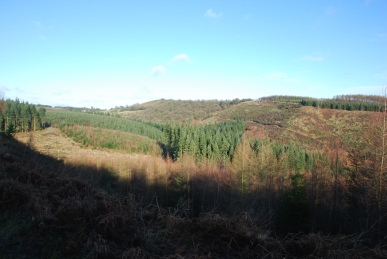 like a very large dog slip away through the trees, a Fallow Deer. The path enters an open space where there is a deer observation tower and then dives down into woodland again. It skirts the top of a tiny valley. Here there are some fine Oaks and the path is covered with their fallen leaves. This path joins a main track down Mary Knoll Valley, the abode of the monster Comus, star of the eponymous masque by Milton. A bubbling stream races down the bottom of the valley. Older paths follow this stream, my path is a newer track gouged out of the hillside. Alders and Silver Birches line the stream. A large flock of Siskins, Redpolls and Coal Tits are twittering loudly in the Alders but fly off just as I get out my binoculars. The track passes a large pond and then Sunny Dingle Cottage. A path leads off back across the hillside. Maddy is off chasing squirrels and disappears completely. I whistle her a couple of times and then wait. Eventually, she comes running down the original track which is now some way below me. Her tail is down and her ears back – she has lost me. I shout and she chases up the bank to reach me and stays within a couple of feet all the way back to the car park, very much chastened.
like a very large dog slip away through the trees, a Fallow Deer. The path enters an open space where there is a deer observation tower and then dives down into woodland again. It skirts the top of a tiny valley. Here there are some fine Oaks and the path is covered with their fallen leaves. This path joins a main track down Mary Knoll Valley, the abode of the monster Comus, star of the eponymous masque by Milton. A bubbling stream races down the bottom of the valley. Older paths follow this stream, my path is a newer track gouged out of the hillside. Alders and Silver Birches line the stream. A large flock of Siskins, Redpolls and Coal Tits are twittering loudly in the Alders but fly off just as I get out my binoculars. The track passes a large pond and then Sunny Dingle Cottage. A path leads off back across the hillside. Maddy is off chasing squirrels and disappears completely. I whistle her a couple of times and then wait. Eventually, she comes running down the original track which is now some way below me. Her tail is down and her ears back – she has lost me. I shout and she chases up the bank to reach me and stays within a couple of feet all the way back to the car park, very much chastened.
Sunday 25th January – Home – This weekend hosts the RSPB Big Garden Birdwatch. Thousands of people spend an hour recording the highest number of each species seen at one time in their garden or the local park. I lurk in the summer house which is cold – very cold. The birding is slow but is suddenly brightened by the unexpected appearance of a female Blackcap, normally a summer visitor to these shores but increasingly remaining all year. A Nutchatch appears on the big tree for a few moments, but otherwise it is the usual suspects. Things are not helped by Maddy regularly coming from her “chicken watch” duties to check I am still here.
Friday 30th January – Home – It has been a damp week. I have, however, managed to find enough dry(ish) time to take the turf off a new vegetable patch and remove the top layer of compressed straw, shavings, mud and droppings from the chicken run and pile it up to dig in later. The chickens have a new mass of litter which they are scratching away at merrily. The gate to the run is faulty and has sprung open a couple of times. On one occasion Maddy attacked Freckles and removed quite a few feathers before Kay dragged her away. The severe telling off, despite the fact that she was only doing what a dog would do, has made her more retrospective, so the next time they got out she just sat and looked on. Catching Spotty and Freckles is quite easy but Ginger leads me a merry dance! Slugs have welcomed the forcing pot placed over the rhubarb and have chomped it. I have put in some beer traps (one way of getting rid of Stella Artois, which no-one seems to like) but they have, somehow, filled with soil. The only open one has not caught anything. The red onions and garlic are doing well. The peas are far less successful but they would have to have been moved as they are in the plot where the greenhouse is going. Broad Beans are doing fairly well and the spaces can be filled with spring sown seed. Snowdrops are now flowering in profusion. There are many more shoots and leaves appearing and hopefully spring wil soon be here, despite the dire weather forecasts for the next week.
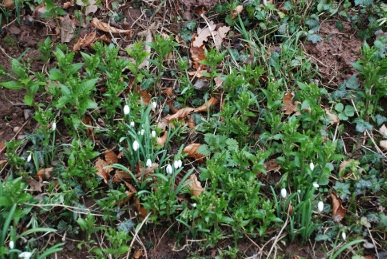
Saturday 31st January – The Weir – A National Trust owned garden on the River Wye to the west of Hereford. On the river are two large Roman buttresses, the northern being over four metres in height. Roman building materials, including dressed stone (many of which still lay on the bed of the river), mosaic tesserae, and painted wall plaster have been found here suggesting a high status building such as a villa with a nymphaeum, a Romano-Celtic shrine devoted to the water nymphs which inhabited the River Wye. Near the buttresses is an octangular stone cistern or water shrine discovered by workmen digging a trench for a new water pipe in 1891. The Romano-British town of Kenchester (Magna) is about ½mile 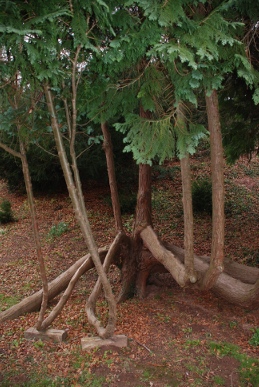 to the north and a Roman road lies a short distance to the west. The estate in modern times had been split up in the 17th century. A farmhouse was owned by Timothy Markham in 1765 and by William Parry in 1788. The latter greatly enlarged then house and set out the gardens, possibly with the aid of Humphry Repton. The garden was further improved by Roger Charlton Parr in the 1920s and he bequeathed it to the National Trust in 1959. The house is now a residential nursing home.
to the north and a Roman road lies a short distance to the west. The estate in modern times had been split up in the 17th century. A farmhouse was owned by Timothy Markham in 1765 and by William Parry in 1788. The latter greatly enlarged then house and set out the gardens, possibly with the aid of Humphry Repton. The garden was further improved by Roger Charlton Parr in the 1920s and he bequeathed it to the National Trust in 1959. The house is now a residential nursing home.
The walk around the garden starts along the top of the slope, passing a rustic shelter built in the 1950s using horses teeth in the floor. Shoots of daffodils are everywhere. Further along the path start drifts of snowdrops, which are extensive throughout the gardens. Yellow Winter Aconites and Primroses adorn the banks. The path drops a little then crosses a wooden bridge below which the side of the hill falls away precipitously to a wall which fends off the swirling flow of the river. The walk continues along the hillside. Old trees, some just huge stumps are surrounded with snowdrops, the shiny green arrowheads of the leaves of Wild Arum, primroses and the tiny green flowers of Dog 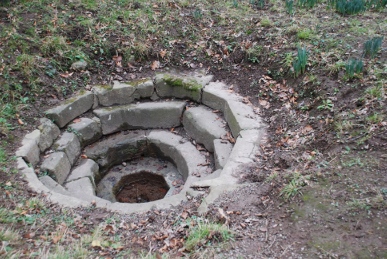 Mercury. At the end of the wood the path returns along the edge of the river. It flows straight towards the wood then turns a sharp 90° turn along the foot of the slope. A leylandii has sent out branches that have drooped to the ground before rising high into the air; wooden blocks have been placed under them presumably to stop them rooting. The path continues by the concrete wall which is preventing the river from eroding the whole hillside away. A set of steps leads down to the water, constructed to provide access for salmon fishing. There is a patch of Winter Heliotrope, a smaller trunk of the Butterbur. Tiny pink cyclamen dot the slope. An early 20th century boathouse is unused now. It is reported that when the Wye floods, Otters use the building as a shelter, leaving footprints in the mud. The large Roman buttresses and the water shrine are passed and then back up to the entrance.
Mercury. At the end of the wood the path returns along the edge of the river. It flows straight towards the wood then turns a sharp 90° turn along the foot of the slope. A leylandii has sent out branches that have drooped to the ground before rising high into the air; wooden blocks have been placed under them presumably to stop them rooting. The path continues by the concrete wall which is preventing the river from eroding the whole hillside away. A set of steps leads down to the water, constructed to provide access for salmon fishing. There is a patch of Winter Heliotrope, a smaller trunk of the Butterbur. Tiny pink cyclamen dot the slope. An early 20th century boathouse is unused now. It is reported that when the Wye floods, Otters use the building as a shelter, leaving footprints in the mud. The large Roman buttresses and the water shrine are passed and then back up to the entrance.